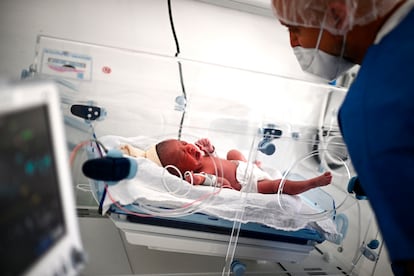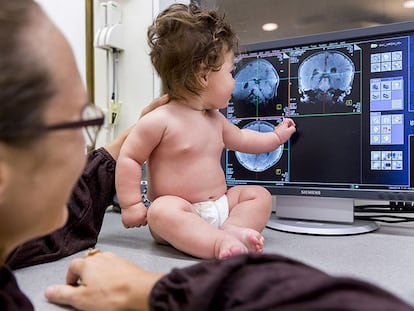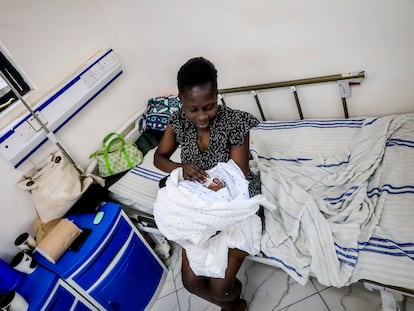Some feminists believe that artificial wombs will be an antidote to the patriarchy, but the prospects are not so clear
Scientists are getting closer to developing the necessary technology to create artificial wombs. However, the potential effects of this are raising political questions

It may seem like science fiction, but the first artificial wombs are already on the way. Several research teams — in the U.S., China, the Netherlands, Australia and Spain — have been developing them for years. The ultimate aim is to help babies survive, particularly those who were born before 26 weeks of gestation.
One team has achieved a successful prototype. This past September, the researchers requested permission from the FDA to move on to the human experimentation phase. The project, called EXTEND, is led by Alan Flake and Marcus Davey, researchers at the Children’s Hospital of Philadelphia. Like the other projects, it aims to help save premature babies, since — at the moment — only 30% of babies born at 22 weeks of gestation survive, according to a study published in the medical journal JAMA.
Spain leads Europe in this technology. “In the future — although we don’t know when exactly — there will be artificial placentas,” Eduard Gratacós claims. He directs the research on this subject at the Clínic de Barcelona and Sant Joan de Déu hospitals. His team has designed an artificial placenta that has kept three sheep fetuses alive for 12 days. The success achieved makes them confident that, within three years or so, they’ll have a prototype that guarantees three or four weeks of survival in premature babies.
An artificial uterus is a much more sophisticated concept than a mere incubator, since it replicates the functions of the mother’s uterus. It’s capable of providing babies with oxygen, nutrients and hormones, until they finish developing. An artificial uterus involves amniotic fluid created in a laboratory and an external device that connects to the baby’s umbilical cord, to oxygenate the baby’s blood. However, this is a technology that — if used for the complete gestation of a fetus — could involve ethical problems.
Are we on the verge of witnessing pregnancies that take place outside the woman’s body? In 1932, Aldous Huxley prophetically recounted the process of ectogenesis in Brave New World, a satire about the contemporary culture of his time (which increasingly resembles our reality).
“Woman? Very simple, say the fanciers of simple formulas: she is a womb, an ovary; she is a female — this word is sufficient to define her,” wrote Simone de Beauvoir in The Second Sex (1949), where she pointed to motherhood as the beginning of patriarchy. “Biological motherhood has long been used as a reason for condemning women to a role of powerlessness and subservience in the social order,” wrote Adrienne Rich — another major activist against heteropatriarchy — in her 1972 essay The Anti-Feminist Woman. Rich defended a reinterpretation of the concept of motherhood that wasn’t linked to a woman’s ability to gestate physiologically or to her responsibility for raising children.
If pregnancy was no longer linked to women, it would change history, allowing for the construction of a feminist society, where women could free themselves from a role that has been assigned to them since ancient times. This was the vision of the Canadian activist Shulamith Firestone, who promoted the most radical stream of feminism in the late-1960s. She advocated for the abolishment of pregnancy, which she described as “barbaric.”
Could artificial wombs be the solution to the gender gap and patriarchal system? Vicente Bellver — a professor of Philosophy of Law at the University of Valencia (Spain) — warns EL PAÍS in a video interview that making pregnancy separate from the body could backfire against women. “In a society that still isn’t feminist, ectogenesis could be very risky, since women may suffer disregard and marginalization [at even greater levels] than today, losing part of the social value that they’ve had throughout history.”
According to Bellver — who has recently been appointed as president of the Bioethics Committee of the Valencian Community — it’s not necessary to revise biology. Rather, it’s best to restructure the social norms that have conditioned biology. “The main source of meaning in human existence is caring [for others]… and the paradigm of all care is motherhood. I believe that society must create the conditions so that motherhood isn’t a heroic exercise. [It should be] compatible with the development of women as individuals, in the workplace, or at the artistic level. Measures must also be implemented — such as paternity leave — to ensure that the partners in this life project can feel fully co-responsible.”
At the moment, the experimental trials comply with current regulations. Hence, there’s no project underway that attempts to implant embryos in an artificial uterus. But the technology to carry out ectogenesis is getting closer and speculation is beginning. Hashem Al-Ghaili — an award-winning producer who hails from Yemen, specializing in science communications — presented EctoLife a couple of years ago, an idea that has since gone viral. He proposed the creation of an incubation factory for 30,000 babies a year in artificial wombs, arguing that it could solve both infertility and problems derived from C-sections, prematurity, or genetic diseases. This could contribute to repopulating countries with low birth rates.
However, French philosopher Henri Atlan — author of the book The Artificial Womb (2015)—– stresses in an interview with EL PAÍS that “these advances in biology [are unable to] suppress the beauty and grace of living creatures even in the slightest, nor can they [replace] the extraordinary richness of human behaviors, nor the sacredness of the human experience.”
An example of how a supervised technology has proven to be beneficial can be found in assisted reproductive technology (ART). When the first baby conceived as the result of IVF was born in 1978, part of the population was shocked. But today, this is a standardized procedure. The International Committee for Monitoring Assisted Reproductive Technologies (ICMART) estimates that, to-date, 12 million children have been born using this technique. In addition, ART has allowed for previously unimaginable options (such as women acting as surrogates for their daughters, carrying their grandchildren in their wombs) and new family models. In this sense, the American writer Jamie Metzl — who is part of the World Health Organization expert advisory committee on developing global standards for governance and oversight of human genome — points out in an email that “humans exist within a cultural context. Our biology, technology and culture are constantly co-evolving.” He also notes that our values are also changing.
Still, procreation through artificial wombs would be controversial from a legal perspective. Josep Santaló — a professor of cellular biology at the Autonomous University of Barcelona — says in an email that “the concept of motherhood would also have to be redefined in these cases. Since there [would be] no surrogate mother, the motherhood of the born child could not be attributed to her.”
Glen Cohen — a vice dean and professor at Harvard Law School — goes even further, noting by email that it would be interesting to start thinking about how ectogenesis could interact with other available technologies. “Since a sperm donor, an egg donor and an artificial uterus can be obtained, children could be conceived without any connection (gestationally speaking) to the people who brought them into the world.” This opens up scenarios regarding the commodification of human life: who would be responsible for the fetus?
Sign up for our weekly newsletter to get more English-language news coverage from EL PAÍS USA Edition
Tu suscripción se está usando en otro dispositivo
¿Quieres añadir otro usuario a tu suscripción?
Si continúas leyendo en este dispositivo, no se podrá leer en el otro.
FlechaTu suscripción se está usando en otro dispositivo y solo puedes acceder a EL PAÍS desde un dispositivo a la vez.
Si quieres compartir tu cuenta, cambia tu suscripción a la modalidad Premium, así podrás añadir otro usuario. Cada uno accederá con su propia cuenta de email, lo que os permitirá personalizar vuestra experiencia en EL PAÍS.
¿Tienes una suscripción de empresa? Accede aquí para contratar más cuentas.
En el caso de no saber quién está usando tu cuenta, te recomendamos cambiar tu contraseña aquí.
Si decides continuar compartiendo tu cuenta, este mensaje se mostrará en tu dispositivo y en el de la otra persona que está usando tu cuenta de forma indefinida, afectando a tu experiencia de lectura. Puedes consultar aquí los términos y condiciones de la suscripción digital.
More information

Science tries to unravel the great mystery of babies’ brains
Últimas noticias
Families demand repatriation of bodies of Colombians who died in Ukraine: ‘This war is a slaughterhouse for foreigners’
James Cameron: ‘For the films I like to make to continue to exist, we have to find a way to make them cheaper’
Helen Levitt, the photographer who captured the theater of the everyday
The guardians of the meteorites of the Argentine Chaco
Most viewed
- Christian Louboutin: ‘Young people don’t want to be like their parents. And if their parents wear sneakers, they’re going to look for something else’
- US sanctions against jailed cartel leader ‘El Marro’ highlight Mexico’s lack of control over its prisons
- Cartels in Mexico take a leap forward with narco-drones: ‘It is criminal groups that are leading the innovation race’
- Liset Menéndez de la Prida, neuroscientist: ‘It’s not normal to constantly seek pleasure; it’s important to be bored, to be calm’
- ‘El Limones’ and the growing union disguise of Mexican organized crime









































